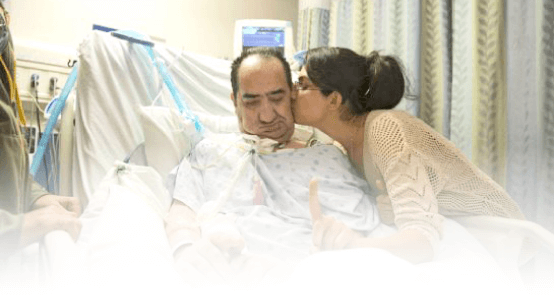Podcast: Play in new window | Download
Subscribe: Apple Podcasts | RSS
Testimonial from a Very Happy Client We’ve Helped to Save a Life after ICU Wanting to Stop Treatment. Quick Tip for Families in ICU.
Hi, it’s Patrik Hutzel from intensivecarehotline.com with another quick tip and also testimonial today for families in intensive care.
So yesterday, I had a phone call out of the blue and there was a gentleman on the phone, and he introduced himself with his name. I’m not going to say his name, but he said to me, “Do you remember me from last year?” And I said, “I unfortunately do not remember you.” And he said, “Well, you were helping me while I was in ICU.” And unbeknownst to me, he was one of our clients but at that stage, I was dealing with his daughter who had engaged our service because her dad was in ICU after he fell off a scaffold four meters, head forward, ended up with a traumatic brain injury and a cardiac arrest. And I’ll talk more about the clinical issues at hands in a minute.
But cutting a long story short, he called me yesterday and he said, “Look, my family has obviously told me everything that’s happened and that they use your consulting and advocacy” and that he thinks he’s only alive today because we helped advocating for him because the ICU was very close in “pulling the plug” and wanting to let him die because they said at the time that even if this gentleman does survive, he won’t have any quality of life. Well, I asked the gentleman yesterday on the phone whether he does have quality of life, and he says, “Yes, I have a very good quality of life. I’m almost back to normal.” And he was talking to me very coherently. Bear in mind that is, more or less, 12 months after a massive traumatic brain injury and a cardiac arrest. He was telling me that he’s walking, he’s eating, and drinking. He’s not back to 100% percent yet, but he says, “I’m so grateful that I’m alive”, and he said it probably wouldn’t have happened without your inputs.
So, I want to share a little bit more about what’s happened there last year. The gentleman fell off a scaffold, four meters at work. “Witnesses reported that he was limped as he fell. Received CPR (cardiopulmonary resuscitation) immediately as witness was trained, and ambulance arrived within minutes reported. The witness was able to restore breathing and the first respondents were ambulance and fire brigade. They introduced a breathing tube and placed the gentleman in an induced coma due to erratic breathing. Both lungs collapsed. He had pneumothoraxes because he fell off the scaffolding and he had chest drains inserted for those pneumothoraxes for the lungs collapsed. These were working for the remainder of the days he has been in ICU and reinflated. Several cracked ribs on both sides. A craniotomy was done due to the high brain pressures and swelling, and an ICP (intracranial pressure) monitor was introduced. The left frontal skull crack, reported, went as planned.”
“He had two drains placed in lungs, some fluids for the first day, but reported this cleared and no further fluids. Day two, ICP which stands for intracranial pressure, was about 16. Low blood pressure and heavy sedation stabilized for the remainder of the day. Day three, repaired the bleed on the spleen with an angiogram, reported, went as planned without complications. Day four, decrease in ICP and discontinued to drop each day and remained stable.
Day seven in ICU, temperature increased, started antibiotics. Reported they were concerned and were investigating sources of infection. Said he would be in ICU for at least the next two weeks and that his prognosis is really poor. Started the cooling blanket. This has been used over the past few days, but he’s currently without this. And we were told the neurologist increased his temperature range. Day eight in ICU, we’re running cold cultures to check for bugs, concerned about a CSF leak. CSF stands for Cerebral Spinal Fluids and things getting in managing temperature with cooling blanket and medication, said that the neck and backbone won’t require surgery and will heal over time. Reported he’s leaking CSF that pulls in the mouth and noted they are concerned about this.
Day 10 in ICU, I think they changed to a wider range of antibiotics due to the ongoing temperature. Vancomycin now at 1000 milligrams. Day 11 in ICU, second lung drain was removed. He had a procedure done to catch any clots via his femoral arteries that may travel up to the lungs. Reportedly, he had small clots in the lungs, so he had an IVC (inferior vena cava) filter inserted. Day 12 in ICU, meant to have surgery to repair facial fractures. Said there was too much risk to leave ICU due to ventilation requirements and blood pressure requirements. Had a spinal drain inserted to manage the CSF leak. Multiple fractures to the facial bones. Did the procedure and ICU reported this has been working to manage the fluid and noted no further fluid in the mouth today. He had a compression machine on his calves but didn’t have this today. They said due to the blood clotting risk. Reportedly, he likely has ventilator associated pneumonia. Ran an EEG today, have not been advised of these results in the last two days. Reportedly, ECG results were normally no markers of a cardiac arrest, have noted any other concerns with the heart. So, troponin was negative.
We’re concerned about a possible liver obstruction but said no as per the ultrasound they said they ran, noted he had some high markers. Has had two MRIs and some CT scans. We were not told about these results other than the original CT, showed a bleed on the left side of the brain. Is it a hypoxic brain injury? The initial scan showed a massive bleed on the left side, swelling on the left side, and possibly some query about hypoxic brain injury.
Day 13 to 15 in ICU, about 36 hours, they weaned him off all sedation. However, he’s currently on noradrenaline , 30 micrograms an hour, and vasopressin, two units per ml per hour. Also, on fentanyl, 20 micrograms an hour. Wondering if this will impact on his responsiveness?
The GCS (Glasgow Coma Scale) said to be 3, however, does show some reflex to touch. Will move his foot right after touch, but also spontaneously, pupils are responsive to light. Hasn’t been offered the tracheostomy. Want to discuss this further with you.”
And this is exactly when the client was starting to engage us because the ICU initially was denying a tracheostomy. After about day 10 to day 14, a tracheostomy should be done if weaning off the ventilator is not possible. So, the ICU initially was refusing a tracheostomy due to perceived poor prognosis. I think that really needs to be highlighted here that their perception was there is a poor prognosis. Well, as we know now, it turned out to be very differently.
So, and then we were successfully advocating for the tracheostomy at the time. I was in meetings with the doctors, with the family and, successfully advocated for the tracheostomy.
“So, then we were told in a meeting that he’s not showing any responses, and nothing has changed in the last 24 hours. They noted his ventilation requirements slightly increased and also his blood pressure requirement. Seeing him this evening, he had a red spot on his stomach and purple coloring in the middle. They said they ran an ultrasound, but we’re not concerned. His stomach was a little firmer than other days, but the nurse said he was due to have a bowel movement and that she has given him medication for that. I have attached some images to this email. My dad, if these are at all useful, please let me know with some feedback.
We were not told about the Clexane injections that were introduced to few days ago for clotting once daily. He has preexisting thrombocytosis condition that was managed via aspirin, blood thinners, and had blood taken out every six weeks or so.”
So, that was sort of the gist last year when we were working with this client. And again, the doom and gloom of the ICU was palpable at every step of the way until the family had someone with myself that could ask the right questions and could hold them to account and could give them example, examples that I’ve seen over the years and that they need to stop being negative. This is a very young man, he’s only in his late 50s and as I said, I was talking to him yesterday and he couldn’t be more thankful for the advice we’ve given to his family to save his life.
So, that is my tip and also testimonial for today.
And there were a few setbacks along the way. He had a craniectomy, meaning they had to remove part of his skull because his ICP, his intracranial pressure, also known as the brain pressures, were very high. And if they hadn’t removed the skull, the intracranial pressures would’ve been even higher, possibly, would’ve led to his death or to another cardiac arrest. So, by them taking off the part of the skull, they could manage the pressure because the brain has more room to expand. And then cranioplasty was done a few months later. There have been other setbacks. He went back into ICU for a pneumonia or for an infection, had sepsis again. But he managed well, and he’s come out of it good.
So, that is a really amazing story and for everyone watching this or listening to this or reading this, you never should lose hope and you should not buy into the doom and gloom of the intensive care team. You should seek a second opinion. You should seek outside advice. You should engage, me and my team, to ask the right questions and we can help you.
So, that’s my tip for today.
If you have a loved one in intensive care, go to intensivecarehotline.com. Call us on one of the numbers on the top of our website or simply send us an email to [email protected].
Also, have a look at our membership area at intensivecaresupport.org . There, you have access to me and my team, 24 hours a day, in a membership area and via email, and we answer all questions, intensive care and Intensive Care at Home related.
Also, we offer medical record reviews for families in intensive care. If you want a medical record review for your loved one in intensive care, we can help you with that. We can do it in real time. ICUs have to give you access to medical records, assuming you are the power of attorney, then we can review medical records in real time. But we can also review them after intensive care stays, especially if you suspect medical negligence.
Now, like the video, subscribe to my YouTube channel for regular updates for families in intensive care, click the notification bell, and comment below what you want to see next, or what questions and insights you have from this video.
Thanks for watching.
This is Patrik Hutzel from intensivecarehotline.com and I’ll talk to you in a few days.
Take care.



